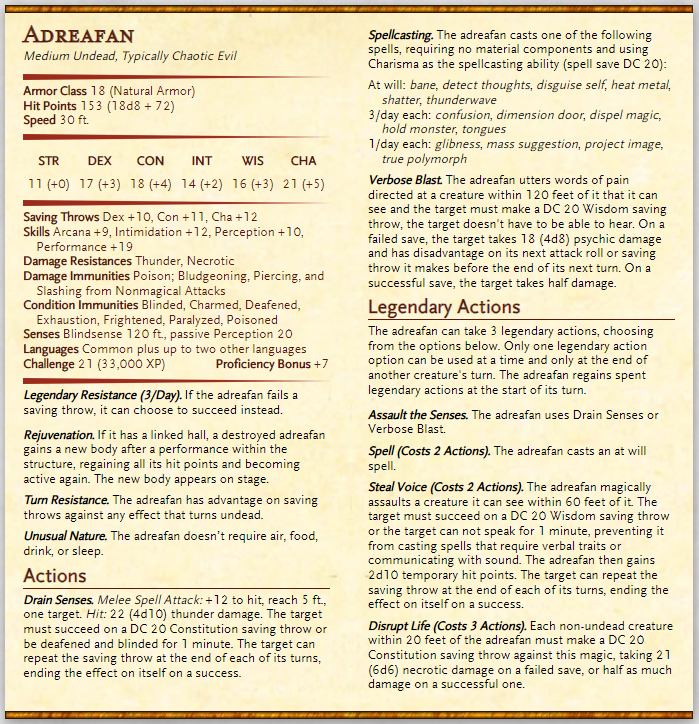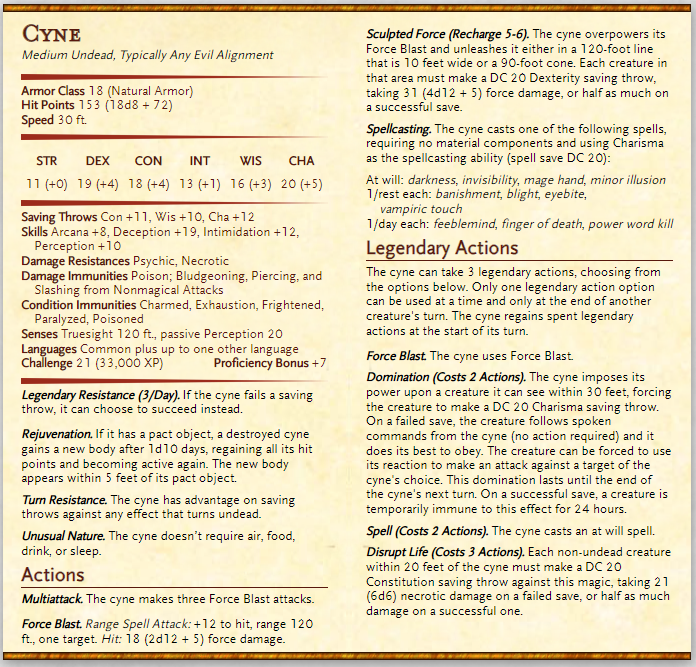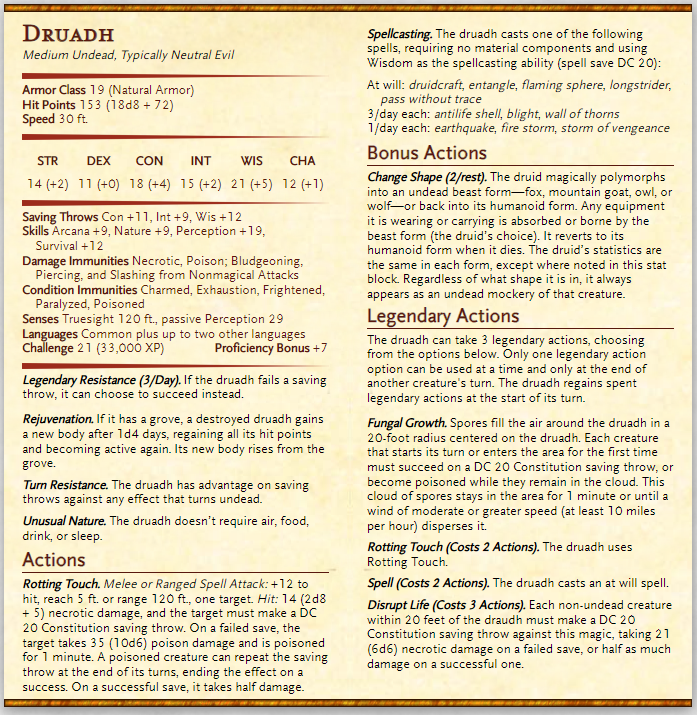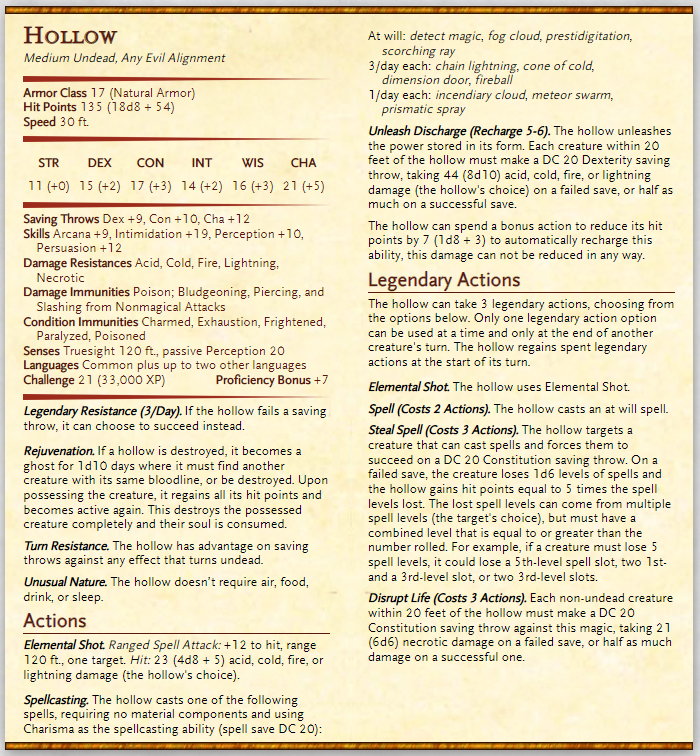Liches for Other Classes
Header Art: Dungeon Master’s Guide by Wizards of the Coast
Everyone has heard of the Lich, a powerful undead wizard who has traded the souls of hundreds of others to further their own existence. Perhaps they believe that their life is worth so much, since they are brilliant wielders of magic or maybe they are just evil. You’ve also heard about mummies, another type of powerful undead with divine cleric powers gifted by the gods. They guard tombs and holy sights, ensuring that interlopers met a gruesome fate.
But what about the other classes? How are they supposed to use their powerful magic to stop death itself from dragging their soul through the plane of shadow and to their final resting place?
For best results in GM Binder, use a Chrome Browser
Adreafan - Bard
An adreafan (pronounced: uh-dree-fin) is a foul creature who must survive on the experiences and sensations of other creatures. In a bard's vain search to secure ever-lasting life, they learned that by taking the sensations of others, they could prolong their own life into undeath, giving them unique qualities that, while not life sustaining, it is unlife sustaining.
After Death. Performers who choose to follow down the path of an adreafan do so because they crave the spotlight and the adoration of others. Their very existence, at least in their minds before death, hinged upon being noticed and loved, or hated, by their followers. So long as they were in the spotlight, they knew they would survive.
An adreafan is nothing without a crowd. If a performer comes along and upstages or steals their fans from them, they will stop at nothing to see the upstager destroyed.
Linked Hall. The beauty of music, of performance, of the glamor and adoration of fans is a powerful force, not that dissimilar to how the gods survive and garner their power off of the worship of followers. An adreafan needs their temple to tie their soul to, allowing it to feed their life force and channel the waves of psychic energy that wash across the performers. These soul-linked structures are often music halls, theaters, and anywhere else where performances are constantly put on to keep the adreafan alive. If a linked hall doesn't see a steady supply of performers, the adreafan grows weaker until they lose their personality and mind, becoming a ravening undead corpse.
An Adreafan's Lair
An adreafan often controls a popular theater, music hall, or some other large structure where large crowds gather to enjoy the performing arts, there have even been adreafan that laid claim to a coliseum devoted to gladiators. Whatever structure an adreafan claims, it must have some connection to them, either as a place where they performed often or the art that is performed there links to them in some way, like those who were musically gifted will have a music hall, while someone who was an actor would have a theater.
These structures aren't without their guards and protections, as when the crowds leave after the performance, the undead walk or glide through the walls and corridors, ensuring that their master is left undisturbed while the adreafan drains the structure of any lingering psychic energy from the adoring fans. It isn't only the adreafan that performs within their linked hall, though they can siphon more sensations when they perform and hate giving up the limelight to others.
Lair Actions
On initiative count 20 (losing initiative ties), the adreafan can take a lair action to cause one of the following magical effects; the adreafan can't use the same effect two rounds in a row.
The adreafan compels a creature it can see within 30 feet of it, and the target must make a DC 20 Wisdom saving throw. On a failed save, the target is magically charmed by the adreafan and immediately uses its reaction to move or to make an attack or cast a cantrip against a creature of the adreafan's choice. The target's charm then ends. A creature that succeeds against this save is temporarily immune to this effect for 24 hours.
The adreafan targets one creature it can see within 60 feet of it. A silence spell fills the space of the target, moving with it until initiative count 20 on the next round.
The adreafan calls forth the spirits of creatures that died in its lair. These apparitions materialize and attack one creature that the adreafan can see within 60 feet of it. The target must succeed on a DC 20 Constitution saving throw, taking 52 (15d6) necrotic damage on a failed save, or half as much damage on a success. The apparitions then disappear.
Lair Traits
An adreafan's linked hall might have any or all of the following effects in place:
Creatures have advantage on Charisma checks while in the structure.
The calm emotions spell, and similar magic, automatically fails.
Voices are twice as loud as normal and it is impossible to whisper.
If the adreafan is destroyed, these effects fade over the course of 10 days.
Cyne - Warlock
Cyne (pronounced: sin) are made up of spellcasters who have made deals and pacts with entities for magical power, such as warlock, and have then absorbed their patron. Since cyne are created by warlocks who break pacts and deals, attacking their patron and attempting to drain the patron of their power, patrons weigh the risks when first offering their knowledge to a petitioner. Unfortunately, they don't always get it right and their protégé turns against them.
Undeath Pact. A warlock that breaks their pact doesn't normally become an undead horror. To create a cyne, a warlock must go through a complicated ritual where objects of importance to their patron are destroyed, and then they must cripple or defeat their patron. Once their patron has been made vulnerable, they can then begin drawing in the patron's power into their form, burning away their soul and mortal flesh so that all that remains are the bones of unlife. This curse is one given from the universe for breaking a soul-bound pact, the one between warlock and patron.
Some warlocks have made pacts with demigods and gods, which makes it a bit more difficult to perform this ritual for everlasting undeath. Instead of siphoning all of the demigod or god, which is considered to be largely impossible due to how powerful such beings are, the warlock instead rips chunks away from the being and absorbs those smaller pieces. It is not recommended for warlocks who seek cynedom to perform this ritual if they made a pact with those beings as they will have made themselves a great enemy that seeks to destroy them, often sending clerics and their followers to deal with the offending warlock.
Pact Object. Upon transforming into a cyne, a warlock's pact object, be it a blade, book, chain, or other object, becomes the source of the cyne's power, granting the undead master immense power... so long as it remains on the cyne. Unlike a lich that will hide their phylactery in far-flung worlds, the cyne must keep the object that houses their patron's soul close to them at all times. If they lose this object, they slowly begin to rot, their body falling apart until they lose all memory of what, or what, they were.
Despite that a cyne must keep their pact object with them at all times, it is oftentimes stronger than a typical phylactery, capable of withstanding most common means of destruction like dropping into lava or submerging in holy water for a decade. The most common way of destroying a cyne's pact object is to find the patron's original place of power, for a vampire lord that might be its original coffin and grave dirt while an elder evil might require a trip into the Beyond, and then performing a ritual of resurrection. Upon its difficult completion, the patron can be released from the object and the cyne can no longer rejuvenate.
A Cyne's Lair
A cyne's lair is often in decrepit castles, ancient towers, and the ruins of distant lands. While these places may seem abandoned, they are from it as the cyne attempts to attract followers and worshipers, even cultivating its network of warlocks, of course, it must be careful or it may end up as its patron, absorbed and destroyed.
Cyne often work with sentient undead, but they also make deals with hags, orcs, and other foul creatures interested in conquering lands and increasing their power. A cyne is single-minded, it must grow its power, which often means that it is in direct conflict with others often.
Lair Actions
On initiative count 20 (losing initiative ties), the cyne can take a lair action to cause one of the following magical effects; the cyne can't use the same effect two rounds in a row.
A wave of necrotic energy rolls off the cyne and each creature within 20 feet of it must succeed on a DC 20 Constitution saving throw. On a failed save, the creature loses 1d4 unexpended Hit Die. If the target has no more unexpended Hit Die, it gains a level of exhaustion.
The cyne looks at a creature within 15 feet of it, filling the creature with fear. The target must make a DC 20 Wisdom saving throw or become frightened of the cyne until the next round at initiative count 20. If the target failed the save by 5 or more, it is paralyzed until then.
The cyne calls forth the spirits of creatures that died in its lair. These apparitions materialize and attack one creature that the cyne can see within 60 feet of it. The target must succeed on a DC 20 Constitution saving throw, taking 52 (15d6) necrotic damage on a failed save, or half as much damage on a success. The apparitions then disappear.
Druadh - Druid
All life must end, but for the druadh (pronounced: draw-duh), they have found that they can extend their life into the grave by studying spores, fungi, and mushrooms that grow upon death. The study of fungi and death is not unusual for most druids, but for the druadh, it is more than just studying it, but mimicking it and entwining their soul with the cycle of rot and death.
Druadh is an ancient title for druids and is the original name for them in their secret, druidic language. Ancient druadh were not masters of undeath, but as time went on, and those ancient masters wished to extend their life beyond their normal timeless life, they soon become synonymous with the tenants of undeath.
Feeding on Life. While most creatures feed on other creatures, like predators hunting prey and humanoids hunting animals, they sustain their life by devouring the dead. Druadh take a similar approach to extending their lives, but rather they feed on the living to sustain their unlife. They first feed on living animals with their groves, placing charms on the beasts that send them to sleep while spores begin to take over the beast's body. They seek to keep a creature alive for as long as possible, so that they may feed on that creature's life force as long as possible.
As the druadh eventually feeds on every creature within their grove, a taint forms, warning all other creatures to avoid the area. Druadh then change who they feed on, looking for living mortals who have more powerful living souls to feed upon. By this point, the slow transition into undeath is complete and the druadh has mastered death.
A Druadh's Lair
The druadh's lair is typically a section of a forest it once watched over before it turned its attention to itself and its need to survive through undeath. This is normally called a druadh's grove, even if there are rotting trees that make up much of its lair. Throughout the grove are humanoid-shaped lumps, the soul food that the druadh is dependent on for continuing its unlife. These lumps were creatures that intruded on the druadh's land or the druadh captured from a nearby settlement. It then laced the person with spores and fungi, slowly channeling the creature's life into energy for the druadh. The creature is still alive, even years after being captured, though by that point, it has lost any sense of identity or personality as its soul is slowly devoured.
These bodies also pull double duty for the druadh. If it is destroyed, when it rejuvenates, it takes the corpse of one of these creatures, rising as a skeletal creature covered in mushrooms, lichen, and fungi.
Lair Actions
On initiative count 20 (losing initiative ties), the druadh can take a lair action to cause one of the following magical effects; the druadh can't use the same effect two rounds in a row.
The druadh targets one creature it can see within 60 feet. The target must succeed on a DC 20 Dexterity saving throw or become restrained for 1 minute by grasping vines and skeletal hands that rise from the ground. Any creature can end the effect on the target by spending an action striking and damaging the vines and hands.
The druadh causes up to four corpses within the grove to rise as skeletons or zombies. They attack any living creature within the grove and have advantage on any saving throw or ability check.
The druadh calls forth the spirits of creatures that died in its lair. These apparitions materialize and attack one creature that the druadh can see within 60 feet of it. The target must succeed on a DC 20 Constitution saving throw, taking 52 (15d6) necrotic damage on a failed save, or half as much damage on a success. The apparitions then disappear.
Regional Effects
A druadh’s grove is warped in any of the following ways by the creature’s foul presence:
Organic matter begins to decay after 10 minutes within the grove, growing dangerous mold and fungi.
Living creatures are unable to expend Hit Dice to regain hit points while taking a short rest within the grove.
Clouds of insects fill the grove, lightly obscuring anything that is 10 feet away or further. After 60 feet, the insects heavily obscure the area.
If the druadh is destroyed, these effects fade over the course of 10 days.
Hollow - Sorcerer
Named after the same process that metallic dragons will undergo to pursue the noble side of undeath, hollows fill themselves with so much elemental energy, that the insides of their body are destroyed. Their flesh and skin act as the husk that contains the elemental energy that powers the undead caster.
Energized Undeath. Unlike the good dragons that hollow themselves out for a noble purpose, spellcasters who undergo the hollow ritual do so only for their selfish desires. The process for a non-dragon to be a hollow is far more dangerous than it is for a dragon, and involves the death of other creatures. The spellcaster must seek out other creatures that have a similar bloodline to it, like how some sorcerers are given magic thanks to draconic blood that flows through them. A would-be hollow must find others like them, and take the power from their blood, a painful process that involves ripping magic from the victim's very soul and feeding it to the hollow.
Once the spellcaster has drained a few others of their magic, and consumed the souls, then they can finish the ritual where their body is transformed into a vessel containing pure energy. This energy is responsible for powering the hollow, though as the years pass, the hollow needs to refill its body with energy, forcing it to hunt down more creatures that share its bloodline so that it can continue its unlife.
If the hollow is ever destroyed, it transforms into an ethereal ghost that has little control over the world. While it is in this vulnerable state, it must seek out another creature of its bloodline and possess them. If it does so, it purges that creature of its soul, transforming the body into its previous form, reforming itself as a hollow. If it takes more than a few weeks for the hollow to find a suitable candidate, it becomes a mindless ghost, incapable of returning to its hollow state from before. Because of this, many hollow send out their henchmen to kidnap victims and keep them imprisoned just in case the hollow needs them for feeding or a new body.
A Hollow's Lair
A hollow makes their lair where ever they are most comfortable. Because they typically look like a living creature, as opposed to the undead that they are, they often fit in well with society. It is only when they are cut deeply that you can see the pure, glistening energy within their bodies, as opposed to blood or bone.
Hollows can often be found in places of powerful magic, perhaps after killing a wizard they may take over a tower, or find a nexus of power that they can feed on as opposed to soul energy, though it is never as filling to them as souls are. The most common areas for hollows are in large population centers, which makes their source for more of their bloodline that much easier. They often host large parties, attempting to meet as many people as possible so that they can keep their eyes on distant bloodlines and take the necessary steps to ensure their existence continues for centuries to come.
Lair Actions
On initiative count 20 (losing initiative ties), the hollow can take a lair action to cause one of the following magical effects; the hollow can't use the same effect two rounds in a row.
The hollow causes a ball of spiked ice to suddenly form and crash into a spot of its choice within 120 feet of it. All creatures within 20 feet of the spot must succeed on a DC 20 Dexterity saving throw, taking 10 (3d6) piercing damage and 10 (3d6) cold damage. The hollow can change the cold damage to either acid, fire, or lightning.
A geyser of acid explodes from the earth under a creature within 60 feet of the hollow that it can see, and the target must make a DC 20 Strength saving throw. On a failed save, the target takes 21 (6d6) acid damage and is knocked prone. On a successful save, the target takes half damage.
The hollow calls forth the spirits of creatures that died in its lair. These apparitions materialize and attack one creature that the hollow can see within 60 feet of it. The target must succeed on a DC 20 Constitution saving throw, taking 52 (15d6) necrotic damage on a failed save, or half as much damage on a success. The apparitions then disappear.
If you want a printer-friendly PDF of this, or any tool or subclass we’ve made, consider supporting us on Patreon! All homebrew that I’ve created or will create in the future will be uploaded to our patreon in printer-friendly versions. We appreciate any and all support!
Like what we are doing here?
Support us on Patreon!
You’ll get early access to deep dives, our Homebrew Hoard, Monster Thursdays, and more!
Follow us on Twitter to keep up to date on everything we talk about!







